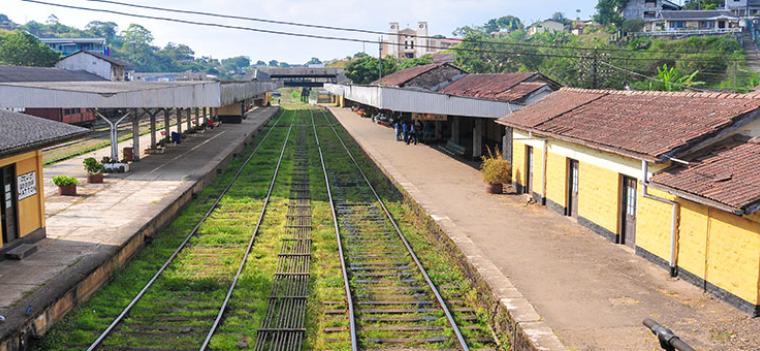News
- As emerging economies like Sri Lanka grow, increasing motor vehicle use contributes to traffic congestion and increases pollution and greenhouse gas emissions.
- With funding from the Energy Sector Management Assistance Program (ESMAP), the World Bank conducted a low carbon urban transport study for Colombo to explore the potential for optimizing the use of public transport.
- The study proposes the development of “multi-modal centers” (MMCs) that would integrate bus, railway, and other public transport services; car and motorcycle parking; and non-motorized transport such as walking or bicycling.
As emerging economies grow and urban areas become more populated, increasing motor vehicle use contributes to traffic congestion and increases pollution and greenhouse gas emissions. In Colombo, Sri Lanka, the proportion of the population using private transportation surged from 26 percent in 1985 to 42 percent in 2013. Travel speed at peak hours averages less than 15 km per hour. Without energy-efficient transport solutions, the problem will just get worse: the population of Western Province, the country’s capital region, is expected to increase from 5.8 million to 8.7 million by 2035.
The core railway network in the heart of Colombo holds great potential for transit-oriented development. With funding from the Energy Sector Management Assistance Program (ESMAP), the World Bank’s South Asia Transport Unit conducted a low carbon urban transport study for Colombo to explore the potential for optimizing the use of public transport.
The study assessed current and future levels of greenhouse gas emissions from Colombo’s urban transport sector, using a transport demand simulation model from the Japan International Cooperation Agency and drawing from an extensive survey of 44,000 households in Colombo. Cost-benefit analyses found that better connections between Sri Lanka’s existing railway and bus networks would attract more people to use public transportation and reduce carbon emissions from private vehicle usage by an estimated 18,000 tons of carbon dioxide in 20 years.
The study proposes the development of “multi-modal centers” (MMCs) that would integrate bus, railway, and other public transport services; car and motorcycle parking; and non-motorized transport such as walking or bicycling. Bus bays, taxi stands, and motorcycle parking will be arranged so that people can walk to and from stations safely on pedestrian bridges.
“Besides rapid motorization and greenhouse gas emissions, metropolitan areas in developing countries like Sri Lanka must overcome financial constraints,” said Mr. Jayasundara Thilakarathna, Additional Secretary (Planning) of the Ministry of Internal Transport. “Effective countermeasures must be technically sound, financially affordable, and politically viable. The World Bank study proposes one such solution through MMC development. The study helps us understand the carbon footprint and other sustainability issues in urban transport while taking into consideration future demand.”
Ragama, a key junction of the Sri Lankan Railway’s network where two lines merge, was selected as one of the pilot stations to determine the impact of improved connectivity on public transport usage and carbon emissions. Near the railway station, Ragama has two separate bus terminals, one right next to the station and the other across the tracks. About 25 buses arrive per hour at Ragama station during morning peak times. With the busy movement of buses, cars, tuk-tuks—three-wheeled motorcycle taxis—and pedestrians, the area has a high risk of traffic accidents.
The development of an MMC at Ragama would also focus on operational aspects such as synchronizing the timetable between bus and rail and a common ticket system for smooth transfers.
With the new proposed layout and operational measures for integration, public transport passengers would benefit from fast, comfortable, and safe transfers at the pilot stations. At Ragama, the development of the MMC would increase the number of passengers transferring from bus to rail from a projected 1,650 per hour at peak times by 2035 to 2,140, a 30 percent increase. The study estimates that CO2 emissions would be reduced by approximately 18,000 tons over 20 years if the MMC at Ragama is developed.
With its close proximity to the capital, Ragama is expected to develop as an urban center as the population of the Colombo Metropolitan Area increases. Integrating the transport system in Ragama would not only improve the convenience of bus and rail transfers, increase pedestrian safety, and create efficient bus circulation and terminal facilities but also increase demand for commercial facilities and municipal services, driving development in the area. The study also recommends constructing a commercial building at the station to capture the increase in land value that the MMC would trigger. The revenue from the commercial floor could be used to cross-subsidize the construction as well as the maintenance of the MMC.
Based on the recommendations of the study, Sri Lanka’s Ministry of Internal Transport, in cooperation with the Ministry of Urban Development, Water Supply and Drainage, will further explore the feasibility of the Ragama MMC through detailed design and analysis. Particular areas to be researched are mechanisms to enhance cross-sector government coordination and a detailed financial scheme to implement the project through public-private partnerships.
In April 2015, the methodology and results of the Colombo study were reported at the Climate Change Targets and Urban Transport Policy conference in Malta and accepted for publication by the journal Climate Change Targets and Urban Transport Policy.
Learn more about the ESMAP Energy Efficient Cities Program.
